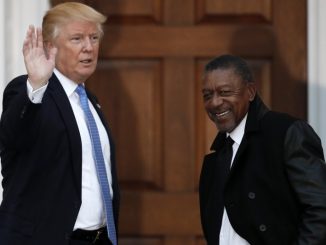
The government had its best budget month in history in April, the Congressional Budget Office said Monday, as a soaring economy put more money into people’s paychecks — and thus more to pay to Uncle Sam.
The Treasury collected $515 billion en route to a monthly surplus of $218 billion, both of which are records. Spending, meanwhile, was up moderately.
President Trump wants to do even more to limit the spending side, the White House told Congress. He said he will send up a $15 billion “rescissions” package on Tuesday and challenge lawmakers to cut money that has been sitting unspent in accounts across the government.
Widget not in any sidebars
Among the 38 cuts he will propose are $4.3 billion in a vehicle technology loan program, $800 million from an Obamacare payment pilot program and more than $200 million that the Obama administration earmarked for the Ebola outbreak that dissipated years ago.
The administration said it is the largest single rescission package any president has ever submitted and would be the first rescissions-only White House proposal to clear Congress in nearly 20 years.
“This is money that was never going to be spent,” said a senior administration official, briefing reporters ahead of the announcement.
ongress will have to approve the package for the cuts to be made. By sending it to Capitol Hill, Mr. Trump is directly challenging Democratic leaders, who fought hard to increase domestic spending in the March government funding deal and who have signaled that they are unlikely to want to cooperate on further cuts.
Officials said they expected no major hiccups in the House, where Republican leaders have been salivating for a fight over spending cuts. The Senate could be a tougher sell, though the administration said some Democrats in the upper chamber have been on record backing similar rescission cuts.
“I don’t see any reason why this would need to be a 50- or 51-vote threshold,” an official said.
Under the rules, a bill like this does not have to face a Senate filibuster, which could help speed passage.
The biggest rescission, covering nearly half of the $15 billion, will come from the Children’s Health Insurance Program, a popular policy that pays for health care for children in low-income families whose parents still make too much to qualify for Medicaid.
The official who briefed reporters said $5 billion of that money is sitting in an account that the president has no authority to spend. The authorization lapsed several years ago. Another $2 billion is a contingency fund.
Senate Minority Leader Charles E. Schumer, New York Democrat, warned Mr. Trump against trying to recapture that money.
“Let’s be honest about what this is: President Trump and Republicans in Congress are looking to tear apart the bipartisan Children’s Health Insurance Program (CHIP), hurting middle-class families and low-income children, to appease the most conservative special interests and feel better about blowing up the deficit to give the wealthiest few and biggest corporations huge tax breaks,” he said.
Also likely to face opposition is a move to revoke money that has been sitting unspent in a Superstorm Sandy relief fund. New York and New Jersey lawmakers are expected to be territorial over that cash. The administration says the money would require a local match, and no local governments have stepped up.
Congress can trim the amount, but it cannot go higher than Mr. Trump proposed.
Rescission packages used to be a staple of Washington, with presidents regularly sending them to Capitol Hill for debate and passage. But the practice fell out of use during the terms of Presidents Obama and George W. Bush.
The administration said it wanted to restore the “muscle memory” for the process and to expect other bills that would go beyond unspent money to cut existing spending plans.
The next one will target duplicative programs, such as the tens of billions of dollars identified by the Government Accountability Office in a report last month.
Congressional Republicans have been seething over the size of government spending since this year’s budget deal and “omnibus” spending bill paved the way for $300 billion in new spending in 2018 and 2019. A majority of that money will go to the Pentagon, but domestic programs are getting a major boost as well.
Republicans were far more excited about the other side of the ledger, though, after passing a major tax cut bill in December. Most analysts said the tax cuts would starve the government of revenue, but Republicans insist a roaring economy will pay for much of the tax cuts.
Widget not in any sidebars
The April CBO numbers don’t reflect most of the tax cuts, which didn’t begin to roll through the economy until the past couple of months.
CBO analysts were surprised by the April surplus, which was some $40 billion more than they predicted less than a month ago.
They said they will have a better idea of what is behind the surge as more information rolls in, but for now said it looks like individual taxpayers are sending more money because they have higher incomes.
“Those payments were mostly related to economic activity in 2017 and may reflect stronger-than-expected income growth in that year,” the analysts said in their monthly budget review. “Part of the strength in receipts also may reflect larger-than-anticipated payments for economic activity in 2018. The reasons for the added revenues will be better understood as more detailed information becomes available later this year.”
Official numbers are due out from the Treasury Department in a few days, but the CBO is usually accurate to within a couple of billion dollars.
April is always a strong month for government finances, with taxpayers filing their returns for the previous year and settling up what they owe, even as expenditures often dip for the month.
But this year was particularly strong, with receipts jumping 13 percent compared with a year ago.
Seven months into fiscal year 2018, the government is running a $382 billion deficit. That is $37 billion worse than last year’s figure through seven months, chiefly because spending has surged 5 percent so far this year.
Higher inflation is driving up the government’s debt payments, while Homeland Security disaster relief, Social Security benefit payments and the Defense Department also reported significant increases.





Be the first to comment